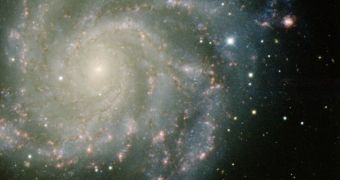On August 24, astronomers managed to catch a supernova in the act of blowing up. What was so remarkable about this event is that it was the first one ever to be imaged as it started happening, providing the earliest known detection of such a blast.
The nearby event was a Type Ia event, meaning that it was produced by a thermonuclear explosion on the surface of a white dwarf. These objects are the helium-burning remnants of Sun-like stars that have completed their main sequence, as well as their red giant phases.
By detecting the 2011fe supernova as early as they did, astronomers were able to find out much more details about its progenitor star than possible by analyzing other events. The explosion occurred in the Pinwheel Galaxy (Messier 101 or NGC 5457), which is located only 21 million light-years away.
Finding the bright flash of light was done by a machine-based, real-time, classification system. The data it obtained of the early stages of the explosion are detailed in two papers that appear in the December 15 issue of the top scientific journal Nature.
The papers also provide interesting insights into the nature of the companion star. Type Ia supernova occur exclusively on white dwarfs in binary systems, since the objects accrete excess mass from companions. It's this excessive accretion that destabilizes them, and triggers the explosion.
“The National Science Foundation- (NSF) sponsored work we did in Berkeley on real-time classification of astronomical time-series helped with this large needle-in-a-haystack problem: we have 1.5 million candidates a night, of which only a few are interesting new transients,” Josh Bloom says.
“Our machine learning-based codes raised the supernova candidate event to the top of list of possible new transients,” adds the investigator, who was a co-author on both Nature articles on 2011fe.
Due to the early detection of the explosion, researchers were able to track the evolution of its brightness, as well as the changes occurring in its energy spectra. In turn, this allowed them to gain more insight into the size of the progenitor star, as well as more data on its companion.
The computational framework astronomers used to conduct this research was set up using funds provided by the NSF, through its Cyber-Enabled Discovery and Innovation (CDI) program.
“No one has done this type of search on this scale before, and as new astronomical surveys come online in the next few years, this framework for extracting novel science from large amounts of data will become increasingly important,” Bloom concludes.

 14 DAY TRIAL //
14 DAY TRIAL //